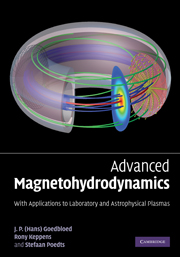18 - Linear dynamics of stationary toroidal plasmas
Published online by Cambridge University Press: 05 March 2013
Summary
Transonic toroidal plasmas
Waves and instabilities of transonically rotating axi-symmetric plasmas is a highly complex problem that is of interest for the two unrelated fields of laboratory plasma confinement, aimed at eventual thermonuclear energy production, and the dynamics of a vast number of astrophysical plasmas rotating about compact objects, broadly indicated as accretion disks. The complexity comes from the transonic transitions of the poloidal flow which causes the character of the rotating equilibrium states to change dramatically, from elliptic to hyperbolic or vice versa, when the poloidal velocity surpasses certain critical speeds. Associated with these transitions the different types of magnetohydrodynamic shocks may appear (see Chapter 20). Obviously, at such transitions the possible waves and instabilities of the system also change dramatically. We here describe these changes for the two mentioned classes of physical systems, starting from the point of view that the continuous spectrum of ideal MHD presents the best organizing principle for the structure of the complete spectrum of waves and instabilities since it is the most robust part of it. It provides the simplest approach to local waves and instabilities of the system and, possibly, to the onset of MHD turbulence.
The equilibrium problem of translation symmetric and axi-symmetric plasmas was formulated by Goedbloed and Lifschitz [181] in terms of three generic functions (see Section 18.2) that permit analysis of the different singularities and the resolution of the concomitant discontinuities that occur in transonic MHD flows.
- Type
- Chapter
- Information
- Advanced MagnetohydrodynamicsWith Applications to Laboratory and Astrophysical Plasmas, pp. 355 - 404Publisher: Cambridge University PressPrint publication year: 2010



